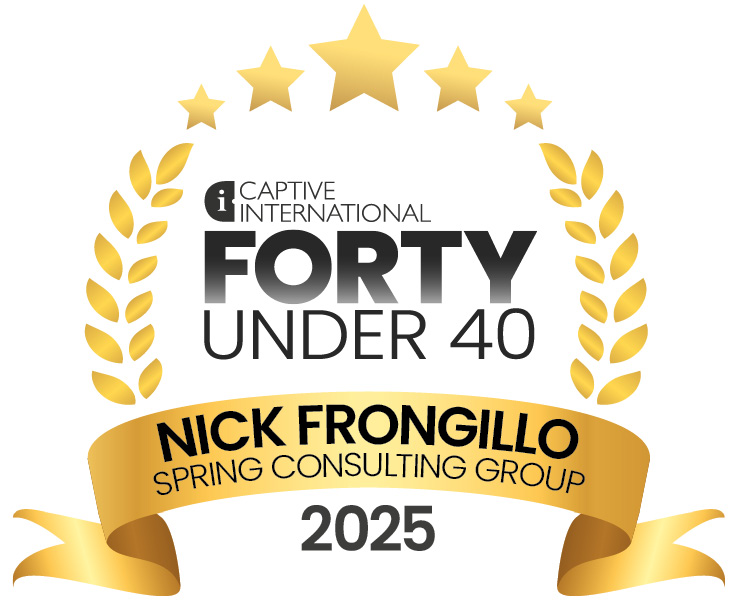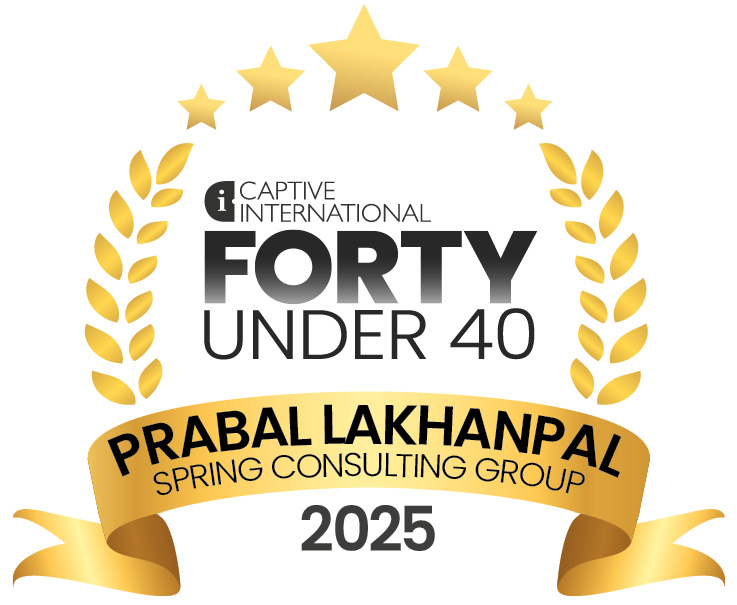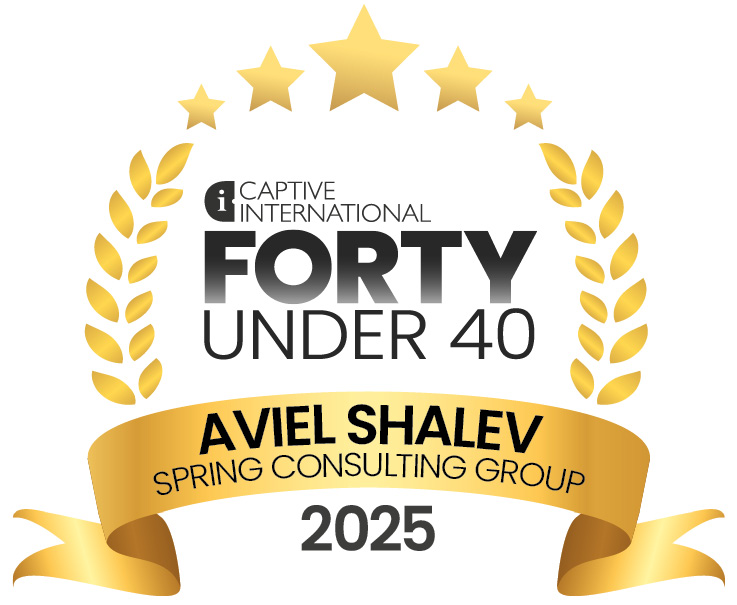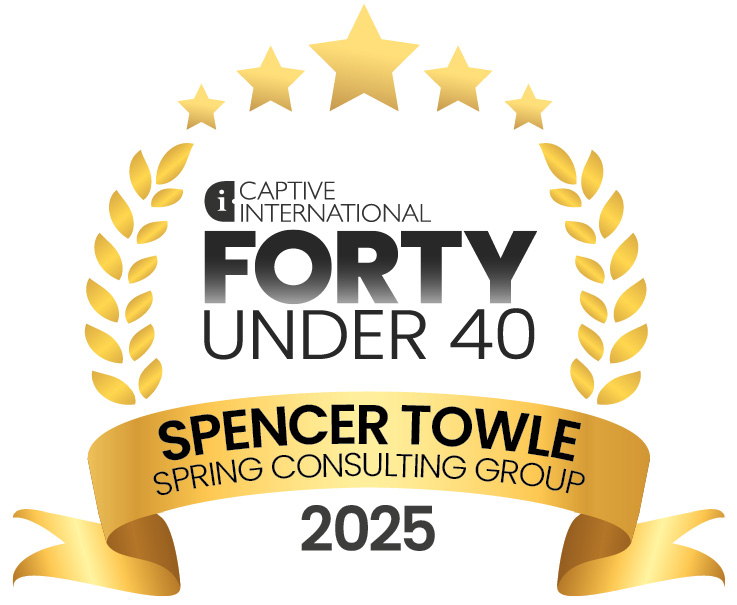We’re excited to announce that our Senior Consulting Actuary, Nick Frongillo, was featured in Captive International’s FORTY Under 40 Awards this year! The award spotlights the most influential figures in captive insurance under the age of 40. You can find his winner Q&A responses here.

We’re excited to announce that our SVP, Prabal Lakhanpal, was featured in Captive International’s FORTY Under 40 Awards this year! The award spotlights the most influential figures in captive insurance under the age of 40. You can find his winner Q&A responses here.

In a recent Financier Worldwide Podcast episode, our SVP, Prabal Lakhanpal speaks about what captive insurance entails; the drivers behind its growing popularity; how businesses can apply it to fund their risks and bridge gaps in coverage; how it can lead to greater capital efficiency and better structuring of risk; and what the next evolution of captives might be. You can find the full episode here.
Captive International recently released its Forty Under 40 Awards, which spotlights the top industry leaders under 40 years old impacting captive insurance. We are excited to announce that four of our colleagues were on this list this year! You can find the full list here.
Prabal Lakhanpal (Senior Vice President)
Nick Fongillo (Senior Consulting Actuary)
Aviel Shalev (Consultant)
Spencer Towle (Analyst)




With the announcement of Captive International’s Forty Under 40, our Consulting Actuary, Nick Frongillo, participated in a panel explaining why they chose captive insurance as a career. You can find the full Q&A here.
In a recent article on Captive.com, spotlighting the CICA session, “Employee Benefits and Medical Stop-Loss: A Partnership between HR, Finance, Risk, and Markets,” our SVP, Prabal Lakhanpal explains the legal process of setting up a captive and results employers can expect. You can find the full article here.
The 2025 Captive Insurance Companies Association (CICA) Annual Conference brought together professionals from across the risk management industry to explore emerging trends and challenges. Held in Tucson, Arizona, this year’s event featured thought-provoking discussions on regulatory updates, emerging risks, and innovative solutions. Below are the key themes that shaped the agenda.
1. Regulatory and Tax Updates
Regulatory changes continue to be a significant concern for captive owners. With the new administration and shifting regulations, staying up to date is critical for ensuring compliance and mitigating risks. Notable compliance-focused sessions included:
– “IRS Audits – Now and the Future”: This session examined the evolving landscape of IRS audits and the impact on captive owners, providing insights into anticipated changes.
– “What’s New / What’s Hot / What’s Not – Tax News You Need”: Presenters explored the latest tax updates that affect captive insurance structures, with a special focus on M&A implications.
2. Emerging Risks: Climate Change and Sustainability
As the world grapples with climate-related challenges, captives are increasingly seen as vital tools for managing environmental risks. This year’s conference addressed how captives can integrate climate resilience into their risk management strategies. Some notable sessions include:
– “Advancing Climate Resilience: Integrating Parametric Insurance and Carbon Credits in Captive Programs”: Spring’s Chief P&C Actuary, Peter Johnson, alongside a representative from the State of Connecticut and CEO of Ryskex, discussed how captives are incorporating parametric insurance and carbon credits to address climate risks.
– “Intersection of Climate Risk and Captives”: This presentation examined the growing intersection of climate change and captive insurance, exploring how captives are playing a role in mitigating climate-related risks.
3. Innovative Technologies in Captives
Technological advancements are revolutionizing captives, enhancing risk management, claims handling, and overall operational efficiency. Technology continues to be a key driver for the future of the industry. Several sessions focused on innovative technology being used in the industry:
– “Future-Ready Risk Control: AI in the Captive Landscape”: This session explored the role of artificial intelligence in transforming risk control within captives, offering a glimpse into how AI will shape the future.
– “Optimizing Captive Management through Best Practices”: Speakers focused on utilizing technology and innovative practices to optimize captive operations. This session provided actionable insights for improving efficiency.
4. NextGen and Diversity in Captive Insurance
The future of the captive industry depends on cultivating a diverse and dynamic workforce. CICA’s commitment to engaging young professionals and promoting diversity was evident throughout the conference. Here are some presentations I thought best highlighted the importance of prioritizing diversity and ensuring the long-term success of the industry.
– “Diversify Your Team, Multiply Your Innovation”: This session highlighted the importance of diversity in driving innovation within captive programs and provided strategies for building inclusive teams.
– “Amplify Women and NEXTGen Networking Luncheon”: A key networking event designed to connect young professionals with industry leaders, providing mentorship and career development opportunities.
As always, the CICA Annual Conference provided a valuable platform for networking, learning, and sharing ideas within the captive insurance community. It was a privilege to engage with so many passionate professionals dedicated to driving innovation and shaping the future of captives. From navigating regulatory complexities and embracing new technologies to addressing emerging risks and fostering diversity, this year’s discussions showcased the dynamic nature of the captive landscape.
As we look ahead, we remain committed to staying at the forefront of these evolving trends and delivering forward-thinking solutions to our clients. We look forward to continuing these conversations and seeing what next year’s CICA conference will bring.
There was a flurry of activity at the federal level that involved state and local paid family and medical leave (PFML) programs in the days leading up to President Trump’s inauguration. Both the Department of Labor (DOL) and the Internal Revenue Service (IRS) provided additional guidance and clarification, which is summarized in this Alert.
I. DOL Opinion Letter Clarifies Interaction of FMLA and State of Local PFML Programs
As the paid leave landscape has evolved, employers have struggled with how to reconcile compliance with the Family and Medical Leave Act (FMLA) with that of state or local paid family and medical leave (PFML) programs. While running FMLA, PFML, and other leaves concurrently has been a common and often recommended practice, understanding specific rules that apply in these scenarios has long been a concern for employers. The Department of Labor, in recently issued DOL Opinion Letter FMLA2025-1-A, finally addresses the interplay between the FMLA and state or local PFML programs when an employee’s absence qualifies for both.
The core issue explored in the opinion letter is how the FMLA’s “substitution” rule operates in these concurrent leave scenarios, particularly regarding the use of PFML and whether the same principles as those that apply to disability plans and workers’ compensation benefits apply to PFML. The substitution rule generally allows an employee to elect, or an employer to require that an employee, substitute accrued employer-provided paid leave (including vacation, PTO, or sick leave) while also falling under the protections of unpaid FMLA leave, which means that the employee can elect to have, or an employer can require, that the employer-provided paid leave run concurrently with FMLA leave. Employers have long been uncertain how to apply the rule when state or local PFML benefits are also involved.
The opinion letter clarifies that the FMLA substitution rule does not apply when employees receive benefits under a state or local PFML program, just as it does not when the employee is receiving paid disability or workers’ compensation benefits. This clarification means employees can choose, or be required by their employer, to use their state or local PFML concurrently with FMLA leave. The DOL emphasizes that this coordination is permissible even if the state or local law does not explicitly address the interaction with FMLA and offers employers a clearer framework for managing these often complex leave situations.
Another key takeaway from the opinion letter is that using state PFML concurrently with FMLA leave does not diminish the employee’s protections under FMLA. The FMLA’s 12 weeks of leave remain protected, regardless of whether the employee receives state or local PFML benefits during that time, thereby ensuring that employees receive the full federal protection of the FMLA while also accessing state or local benefits.
Additionally, the DOL’s guidance touches upon the implications of PFML providing partial income replacement. If an employer offers employer-provided accrued paid leave benefits in addition to state or local PFML, the opinion letter suggests that these employer-provided benefits can also be used concurrently with FMLA leave to “top off” the PFML benefit.
This opinion letter is significant because it provides much-needed clarity in an area where confusion often arises. The increasing prevalence of state and local PFML programs necessitates clear guidance on how these laws interact with the FMLA. By addressing the substitution rule in this context, the DOL helps employers navigate the complexities of concurrent leave and ensures employees understand their rights and options.
Ultimately, FMLA2025-1-1 aims to streamline the administration of FMLA leave when state or local PFML is involved, promoting a more consistent and predictable approach for both employers and employees. It reinforces the principle that the FMLA provides a baseline of protection, which can be supplemented by state benefits, without diminishing the federal entitlement.
Next Steps for Employers:
Employers should carefully review DOL Opinion Letter FMLA202-1-A and ensure that their current policies and procedures are consistent with the new guidance.
II. Navigating the Tax Implications of State PFML Programs
The rise of state-level PFML programs has brought a wave of tax-related questions from employers, employees, and other stakeholders. Previously, state guidance on PFML taxation was often vague, leaving many to seek expert advice. However, the IRS issued Revenue Ruling 2025-4, providing much-needed clarity on these complex issues.
Federal Tax Implications:
- Employer Contributions: Generally, employer PFML contributions are excluded from an employee’s gross income and are not subject to FICA, FUTA, or federal income tax withholding.
- Employee Contributions: Employee PFML contributions are typically considered after-tax and are therefore not subject to federal taxation. If an employer funds the employee portion, this payment is considered additional compensation and is subject to FICA, FUTA, and income tax withholding.
- Benefits Paid: The tax treatment of PFML benefits depends on whether the leave is for medical or family reasons, and whether the benefit is attributable to employer or employee contributions. Some states specify contribution allocations (e.g., Delaware, Massachusetts, Minnesota, New Jersey, New York), while others do not, potentially creating ambiguity for employers.
- Medical Leave:
- Employer-Attributable Benefits: Included in federal gross income as wages, subject to sick pay reporting rules, and considered third-party payments of sick pay.
- Employee-Attributable Benefits (or Employer-Funded Employee Portion): Excluded from federal gross income.
- Family Leave:
- Employer-Attributable Benefits: Included in federal gross income (not wages). The state must file with the IRS and issue a Form 1099 to the employee.
- Employee-Attributable Benefits (or Employer-Funded Employee Portion): Included in federal gross income (not wages). The state must file with the IRS and issue a Form 1099 to the employee.
- Medical Leave:
State Tax Implications:
State tax treatment of PFML contributions and benefits varies. Employers must consult the specific laws, rules, regulations, and guidance for each state program to ensure compliance.
PFML Contribution Requirements:
In 2025, state PFML programs have varying requirements for employee and employer contributions when the employer participates in the state plan. Exceptions may apply based on employer size or private plan offerings. Consult the specific state program details for accurate contribution requirements.
Next Steps for Employers:
Employers should carefully review Revenue Ruling 2025-4 and any related state guidance. During the 2025 transition period, adjustments to taxation practices may be necessary. This may include updating employee handbooks, policies, FAQs, payroll systems, and other relevant resources. Proactive compliance is crucial, as employers are generally responsible for the correct administration of these programs.
For further questions or assistance regarding either the DOL Opinion Letter or the IRS Revenue Ruling, please contact Spring.
History of MHPAEA
Mental Health Parity is designed to ensure individuals receive equal access to Mental Health and Substance Use Disorder (MH/SUD) benefits as they do for Medical and Surgical (MED/SURG) benefits. This quest for parity began legislatively in 1996 with the Mental Health Parity Act (MHPA), prohibiting insurance companies from imposing more restrictive annual or lifetime dollar limits on mental health benefits than MED/SURG. Since then, many regulations have been passed to help achieve this goal.
- In 2008, the Mental Health Parity and Addiction Equity Act (MHPAEA) incorporated additional provisions, enforcing that financials (copays or deductibles) and treatment limitations (number of visits or days of coverage) were equal, as well as applying all requirements to substance use disorder benefits.
- Additional MHPAEA regulations were published in 2013, providing much more guidance on how to achieve compliance.
- The Consolidated Appropriations Act of 2021 introduced the requirement to perform a comparative analysis of non-quantitative treatment limitations (NQTL), such as preauthorization, network administration standards, or step therapy. However, nearly all the analyses submitted were found insufficient.
Despite previous efforts and regulations, disparities between MH/SUD and MED/SURG benefits have continued to grow over the last 15 years. In 2022, according to the Substance Abuse and Mental Health Services Administration’s (SAMHSA) National Survey on Drug Use and Health (NSDUH), almost 54.6 million people aged 12 and older were diagnosed for needing treatment for substance abuse, and only 24% of that population were able to receive treatment.1 Additionally, a study by RTI International showed that in 2021, out-of-network behavioral health clinician office visits were reported to be 3.5 times higher than all MED/SURG out-of-network office visits.2
Final Rules to the MHPAEA were released by the Departments of Labor, Health and Human Services, and the Treasury on September 9th, 2024, with the intent to rapidly address these barriers. These rules take effect on January 1, 2025, with some requirements having a delayed application until January 1, 2026. The Final Rules expand on previous requirements, provide clarification for group health plans and health insurance issuers to stay compliant with MHPAEA, and aim to eliminate any restrictions on MH/SUD treatments or resources, ensuring the same level of coverage as MED/SURG benefits.
The final regulations are complex and will be cumbersome for all employers, especially those with self-insured plans. At the core of the regulation are two requirements: a Benefit Coverage Requirement and an NQTL Comparative Analysis Requirement.
Benefit Coverage Requirement
This review must ensure that financial requirements and quantitative treatment limitations (QTL) are not more restrictive when comparing MH/SUD and MED/SURG benefits. The final rules remove away from the tests mentioned in 2013 and emphasized that plans cannot impose an NQTL that is more restrictive on MH/SUD benefits compared to MED/SURG benefits. To determine whether the NQTL meets the requirement to be no more restrictive, the plan must satisfy both a Design and Application Requirement as well as a Relative Data Evaluation Requirement.
Design and Application Requirement: Plans must show that the processes, strategies, evidentiary standards, and other factors used when both designing and applying the NQTL are comparable, rather than the previously only evaluating the application itself. Additionally, a key provision prohibits using discriminatory factors or evidentiary standards when designing the NQTL.
When evaluating the plans, the regulation is clear that health plans must provide “meaningful benefits,” which entail covering at least one core treatment in each category for MH/SUD benefits, as they do for MED/SURG. The six recognized categories are emergency services, in-network inpatient, out-of-network inpatient, in-network outpatient, out-of-network outpatient, and prescription drugs. For example, if a health plan covers a hospital surgery in the inpatient category, it must also provide access to mental health treatment, such as inpatient psychiatric care, in the same category. If they provide antibiotics in the prescription drugs category, they must also provide antidepressants.
Data Evaluation Requirement: Plans must collect and evaluate data to assess the relevant outcomes of applying the NQTL. Plans and issuers must identify material differences in access to services and take reasonable action to address them. Although the Departments will not provide a set list of required data, they expect plans to collect data relevant to most NQTLs, allowing flexibility based on the NQTL in question. If data is lacking, plans must state why it is missing, how they will collect it in the future, or provide a reasoned justification concluding no data exists.
If the Departments determine that the NQTL is more restrictive and that the above requirements are not met, they can enforce plans to stop imposing the NQTL on their MH/SUD benefit offering.
NQTL Comparative Analysis Requirement
The Final Rules reiterate the need for an NQTL comparative analysis, which has been a requirement since the CAA (2021). The analysis requirements are robust, requiring the Plan to explain how and why the Benefit Coverage Requirements are satisfied within their NQTL Comparative Analysis. This narrative must be detailed and include the following Content Elements:
- Description of the NQTL, including identification of benefits subject to the NQTL
- Identification and definition of the factors and evidentiary standards used to design or apply the NQTL
- Description of how factors are used in the design or application of the NQTL
- Demonstration of comparability and stringency, as written
- Demonstration of comparability and stringency, in operation, including the required data, evaluation of that data, explanation of any material differences in access, and description of reasonable actions taken to address such differences
- Findings and conclusions
This analysis must consider all facets of the plan, including core treatment, standards of care, utilization, access, networks, prior authorizations, etc. The plan must assess any material differences and what meaningful actions are being taken to ensure compliance.
For ERISA-covered plans, the named plan fiduciary must verify an appropriate analysis was conducted with a prudent process. Fiduciaries are also responsible for continually monitoring the plan and compliance with the NQTL analysis.
The comparative analysis must be readily available upon request and provided within the specific timeframe: 10 business days for the relevant Secretary, and 30 days for participants or beneficiaries. If an insufficient analysis is determined, plans must submit additional information within 10 business days. If there is an initial determination of noncompliance, they have 45 calendar days to make corrections. If there is a final determination of noncompliance, the plan must inform all enrolled participants and beneficiaries within 7 days and provide the Secretary with a copy of this notice, along with the names of everyone involved in the process.
Action Plan
The Departments recognize that employers with self-insured health plans rely on TPAs and service providers for plan administration and understand the challenges in obtaining the necessary comparative analyses or required data. However, plans and issuers are ultimately responsible for compliance with MHPAEA. If you don’t already have a comparative analysis on hand, it should become a top priority due to the quick turnaround response times outlined. It is recommended to consult with a legal partner for an in-depth analysis. Additionally, the MHPAEA Final Self-Compliance Tool, finalized in 2020, serves as a valuable resource, guiding plans and issuers to meet compliance with MHPAEA’S parity requirements. This tool has not been updated, but that is expected.
The Final Rules generally apply starting January 1, 2025, though provisions like meaningful benefits and certain comparative analysis requirements are delayed until January 1, 2026, to give employers more time to comply.
Although we recommend that employers carefully examine their plans and work toward immediate compliance, a lawsuit has been filed and more are anticipated. The lawsuit from ERIC (The ERISA Industry Committee) indicates that the new regulations are fundamentally flawed, exceed the statutory authority that Congress provided to the agencies and threaten the ability to offer quality and affordable benefits in compliance with applicable laws.
1 SAMHSA (2023), Key substance use and mental health indicators in the United States: Results from the 2022 National Survey on Drug Use and Health (HHS Publication No. PEP23-07-01-006, NSDUH Series H-58), https://www.samhsa.gov/data/report/2022-nsduh-annual-national-report.
2 Mark, T.L., Parish, W. (2024), Behavioral health parity—Pervasive disparities in access to in-network care continue, RTI International, https://dpjh8al9zd3a4.cloudfront.net/publication/behavioral-health-parity-pervasive-disparities-access-network-care-continue/fulltext.pdf.